Existing User Log In
New User Registration
Register for a free account to gain full access to the VGChartz Network and join our thriving community.



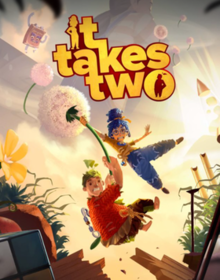

America - Front


America - Back

Hazelight
Action-Adventure
 (Add Date)
(Add Date) (Add Date)
(Add Date) (Add Date)
(Add Date)
| Owners: | 0 |
| Favorite: | 0 |
| Tracked: | 0 |
| Wishlist: | 0 |
| Now Playing: | 0 |
[Reviewer's note: Since part of what makes this game so fun are the gameplay surprises, if you haven't played it then perhaps not thoroughly reading this review would be better for you. Obviously I won't be an open book about everything; nevertheless, there are several mechanical concepts I'm yearning to dissect (as subtly as possible). Viewer discretion is advised.]
Three years after A Way Out was making waves for its mandatory two player co-operative gameplay, developer Hazelight has released its next IP based on that unorthodox conceit. It's critically important to internalize upfront that there is no single player campaign here. This stricture may seem arbitrary at first glance, but as with the team's previous title, the prism of co-op level design and mechanics demands a specific focus. The final result is an experience that'll rank not only as one of the best games of the year, but also one of the most unforgettable rides of this decade.
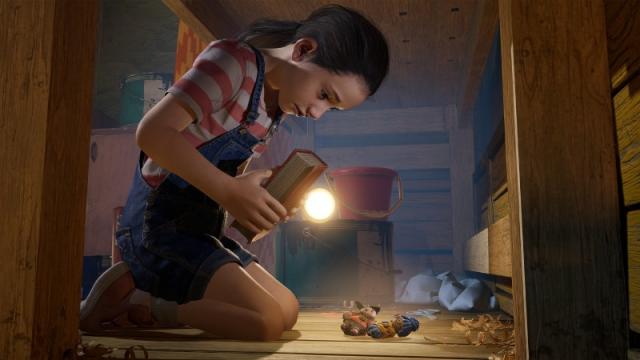
Cody and May are getting a divorce. They've just broken this unfortunate plan to their precocious daughter, Rose, who takes her hand-made dolls and a mysterious marriage therapy book to the family shed. After play-acting with these clay & wooden facsimiles of her parents, she incidentally casts a spell on the pair, resulting in them becoming trapped within these new bodies. Now no more than five inches tall and with everything within the world coming to life, Cody and May must overcome treacherous obstacles to reach Rose and reverse the spell. With the "assistance" of Dr. Hakim, that now-anthropomorphic therapy book, the two also have the opportunity to mend their fractured marriage.
It's a simple set-up that gains a lot of traction thanks to its world-building and fervent creativity. Initially, your expectations can be like that of Toy Story: a simple shed now feels like navigating a skyscraper and virtually every tool has a personality. But then there's another level in that the world itself exists on a different plane or dimension (so to speak). The levels are like labyrinthine mazes while still replicating the real world. You'll never stop being surprised with where the adventure goes next.
Beyond the premise itself, It Takes Two also does an admirable job with respect to script-writing and tone. This ought to be stressed here: don't expect to wholeheartedly like either Cody or May from the outset. Since we're dealing with a beleaguered couple already considering child custody schedules, of course you'd anticipate them to have less-than-stellar manners towards each other. I respect that approach even more because it takes real confidence to play the long game with your audience. The writers took some extreme liberties (especially for a Teen rating) to showcase this couple's selfish side, but it's one that ultimately paid off for me.
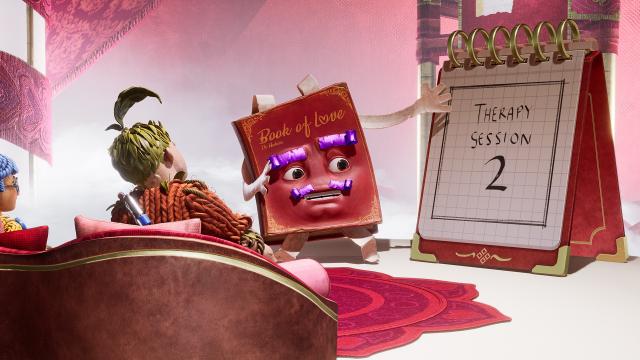
Such positivity can also be applied to the presentation and how that complements pacing. First, the consortium of voice actors are quite talented; when even the child actor manages a decent performance, you can tell casting put in the work. The one bugbear I’d make comes back to the extravagant Dr. Hakim. Joseph Balderrama's seductive Spaniard impression, tied with the book's silly pink eyebrows and moustache, can be a bit too much; plus, the comedy writing for him is hit-or-miss. That aside, the general ebb 'n flow of levels, along with great visual framing, makes each place feel tangible yet also larger than life.
The premise and its themes revolving around companionship are relatively simple, but it's the earnestness that hit me hardest. It's a narrative that's practically effusive about its fun concepts and it never wants to let up. I can make some nitpicks like "Antonio Bookderas" and his occasionally forced comedy, but even then my annoyance is cooled because I respect the writers betting all their chips on that style. It Takes Two's story winds up being more than the sum of its parts.
As I mentioned during the beginning of this review, it's important to remember the co-op prerequisite. For those unfamiliar with Hazelight's previous title, this translates to your screen being vertically sliced down the middle - May occupying the left side while Cody gets the right. Players preliminarily select which character they want and enjoy the disparate roles between them.
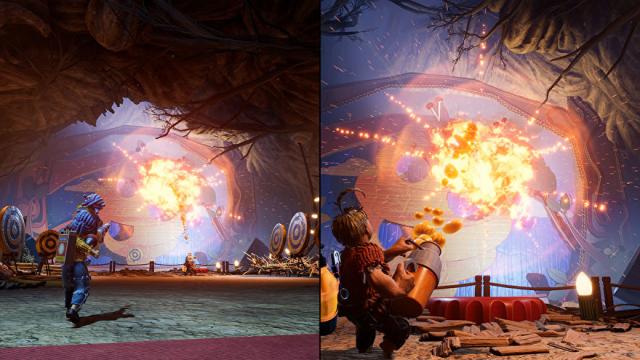
Before going into variety and level design, credit's immediately due to the level of polish. Although I can't personally speak for lower-tiered Xbox consoles, the general sensation and framerate ran smoothly from beginning to end on a Series X. Beyond the impressive scope and minute details to appreciate, especially the strands from May's burlap clothing & hair, a lot of dedicated work went into the animations. Platforming feels incredibly tight and responsive. I'm a sucker for platformers that enable exploits like dash-spamming while sprinting and whatnot. The basics of running, jumping, pipe-grinding, wall-hopping, and so on feel incredibly smooth. Take away occasional camera mishaps and then I’m more tempted to say it belongs up there with the platforming A-listers.
The basics aren't where It Takes Two intends to shine. The bread 'n butter of its gameplay is the panoply of mechanics specialized for co-op maneuvers. One of the earliest examples is – humorously – tied to my occupation: hammer and nails. May straps a hammer on her back for bashing things while Cody can throw and telepathically call back nails, a la Guardians of the Galaxy's Yondu. The way perspective, puzzles, and even mini-games are managed with this core concept felt thoroughly considered and rewarding. And this is just the beginning! Remember the earnestness about its story I mentioned? That’s even more the case with respect to these ideas. It's as though infectious enthusiasm is baked into the game's code and you're left wondering why we don't see this more often.
Being treated with multitudinous goodies wouldn't go very far without thoughtful level design. There's one area in particular that speaks to this, in gameplay and story. Since this story's about rekindled love, obviously attraction will play some part in this recovery effort. What I respect most are the various dynamics at play when attraction is reintroduced:
There's this layered, cohesive relationship between backstory and gameplay here that makes it a standout example of level design. Along with fun ancillary distractions and standout writing moments, these bonuses solidify it as being the best portion of the adventure.

Another compliment about said levels and game design circles back to this idea: a "just one more thing" approach to puzzles and set pieces. One of my co-op partners actually gave his misgivings about things being "too much." Although I understood his admonition, I came away admiring my expectations being challenged. The key for something may be in arm's reach, but instead of concluding with the bigger conundrum there's now an extra micro-puzzle before finally attaining the MacGuffin. The same expansionary intention goes back to levels doubling as towns. My partner and I spent around 10 minutes sledding on a half-pipe just for kicks. If you're naturally curious you'll find other funny design secrets and Easter eggs hidden elsewhere. Hazelight is never content with surprising you 20 times; it has to be 21 times bar none.
For all of my crazy gushing (which I could keep doing), that doesn't mean it’s flawless. I wasn't a big fan of a quick boating section. I also take issue with some design decisions in the penultimate level. For the sake of avoiding direct spoilers, I'll just say May’s limited abilities against one specific enemy got on my nerves. My copious deaths within two of the combat arenas sometimes felt unwarranted. The singular bad instance of playing online (thus far) occurred after my partner's controller died. He completely disappeared from my screen and my response time felt noticeably laggy. This issue didn't fix itself until we reached the next cut scene.
These misgivings barely distract from what's otherwise my current favorite game to discuss. I recall reviewing Never Alone and thinking back about how compromising the protagonist-duo adventure subtracted from the overall experience – moreso in its expansion. Hazelight showed it was possible to fully integrate a two-person template with A Way Out. Since no one else seemed interested in this style, the team continued building upon that solid foundation. I can sympathize with those who dislike the hurdle, but you'll implicitly understand and appreciate its importance upon experiencing it.

Although I've previously mentioned certain presentational qualities, I'm compelled to re-emphasize how impressed I am with such a modest AA-budgeted title. Compared to the Hollywood wannabe-isms & ostentatiousness of David Cage, Josef "F*** The Oscars" Fares succinctly uses his film experience to frame and edit shots with player experience chiefly in mind. There's a yearning to visually communicate the history of each locale while prioritizing player comfortability, which I truly admire. Sound design also does an exceptional job in both sounding detailed and telegraphing importance to the player. Finally, Gustaf Grefberg's respectable soundtrack takes an inspired route of limiting itself for some locations and playing a central role in others.
Were I to strictly focus on the campaign and nothing else, I'd unabashedly say It Takes Two is worth every penny. The extra mini-games are wonderful surprises, even if some are better than others, and replayability effectively doubles if you want to restart as the other character. Those are great considerations! But I'm more interested in emphasizing the 11-14 hour main story here. It really says something when so many gameplay vignettes reach their end and you feel satiated. That's the same sensation I felt upon reaching the end credits too. Tie this with the Friend Pass, requiring only one person to own the full version to play the whole campaign, and the value speaks for itself. That pro-consumer move deserves Hazelight's financial support all on its own.
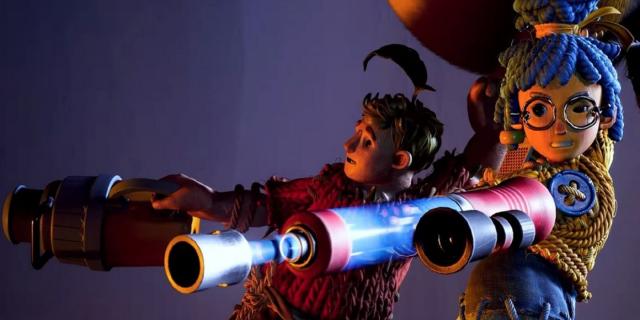
Like A Way Out before it, It Takes Two harnesses a specialized co-operative template for the betterment of the story it's trying to tell. The hurdle may be a bit obstructive for some, but the pay-off is playing one of the best games since next-gen began. The effusive energy and variegated mechanics aren't just meant as simple trinkets either; they tie in to the core theme of companionship in a genuine way. Even with the few slightly irksome qualities previously stated, Hazelight's latest is a joyous jaunt I can't stop talking about with anyone who’ll listen. Whether looking at its rare gameplay structure, interesting premise, or great production values, every element works in tandem to make for an experience that's one-of-a-kind.
Despite being one of newest writers on VGChartz, Lee has been a part of the community for over a decade. His gaming history spans several console generations: N64 & NES at home while enjoying some Playstation, SEGA, and PC titles elsewhere. Being an Independent Contractor by trade (electric, plumbing, etc.) affords him more gaming luxuries today though. Reader warning: each click given to his articles only helps to inflate his Texas-sized ego. Proceed with caution.









